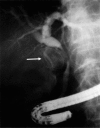Hilar cholangiocarcinoma: diagnosis and staging
- PMID: 18333200
- PMCID: PMC2043098
- DOI: 10.1080/13651820500372533
Hilar cholangiocarcinoma: diagnosis and staging
Abstract
Cancer arising from the proximal biliary tree, or hilar cholangiocarcinoma, remains a difficult clinical problem. Significant experience with these uncommon tumors has been limited to a small number of centers, which has greatly hindered progress. Complete resection of hilar cholangiocarcinoma is the most effective and only potentially curative therapy, and it now clear that concomitant hepatic resection is required in most cases. Simply stated, long-term survival is generally possible only with an en bloc resection of the liver with the extrahepatic biliary apparatus, leaving behind a well perfused liver remnant with adequate biliary-enteric drainage. Preoperative imaging studies should aim to assess this possibility and must evaluate a number of tumor-related factors that influence resectability. Advances in imaging technology have improved patient selection, but a large proportion of patients are found to have unresectable disease only at the time of exploration. Staging laparoscopy and (13)fluoro-deoxyglucose positron emission tomography (FDG-PET) may help to identify some patients with advanced disease; however, local tumor extent, an equally critical determinant of resectability, may be underestimated on preoperative studies. This paper reviews issues pertaining to diagnosis and preoperative evaluation of patients with hilar biliary obstruction. Knowledge of the imaging features of hilar tumors, particularly as they pertain to resectability, is of obvious importance for clinicians managing these patients.
Figures




References
-
- Nagorney DM, Donohue JH, Farnell MB, Schleck CD, Ilstrup DM. Outcomes after curative resections of cholangiocarcinoma. Arch Surg. 1993;128:871–9. - PubMed
-
- Hakamada K, Sasaki M, Endoh M, Itoh T, Morita T, Konn M. Late development of bile duct cancer after sphincteroplasty: a ten- to twenty-two-year follow-up study. Surgery. 1997;121:488–92. - PubMed
LinkOut - more resources
Full Text Sources
Research Materials

